|
Matt's views on Rugby and
the professional era
As a young fellow growing up on the Far
North Coast of New South Wales I came under
the spell of Rugby through my Dad's association
with the Coffs Harbour Rugby Club: The Snappers!
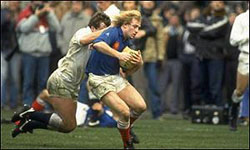 It
was of course an amateur code then, a game
played for the love of it, not money. Rugby
is still largely dependent upon amateurism
for its survival as only the elite levels
of the game receive fiscal rewards for their
efforts on the paddock. However when I was
growing up Rugby was the great sporting
bastion of amateurism throughout the world.
Rural rugby clubs of today like yesteryear
remain, on the whole, amateur and they survive
and thrive because of the determination
of a bunch of people believing in the local
club. Coffs Harbour was and is no exception
to this rule. It
was of course an amateur code then, a game
played for the love of it, not money. Rugby
is still largely dependent upon amateurism
for its survival as only the elite levels
of the game receive fiscal rewards for their
efforts on the paddock. However when I was
growing up Rugby was the great sporting
bastion of amateurism throughout the world.
Rural rugby clubs of today like yesteryear
remain, on the whole, amateur and they survive
and thrive because of the determination
of a bunch of people believing in the local
club. Coffs Harbour was and is no exception
to this rule.
Having been around the Coffs Harbour Rugby
Club since I was a baby the red and black
of our strip was a familiar and comforting
sight. It stirred up a sense of allegiance
long before I really knew what the game
was all about. It has to be said that my
main sporting interest was cricket when
I was a boy. Around the age of ten to thirteen
cricket held a great deal more appeal and
in hindsight this was largely thanks to
television and the manner in which it made
the game particularly accessible to me,
as a spectator. Dad and I used to make a
trip once a year to the Sydney Cricket Ground,
and thanks to friends, we managed to get
seats in the Members and watch the Australian
First XI do battle with bat and ball. Then
as my tentative teenage years began I was
drawn to Rugby and watching more regularly
the efforts of the Club that Dad had coached
for ten years before he advanced onto take
charge of the NSW Country Team and later
the NSW B and NSW Rugby sides.
I regard myself as having had a very privileged
relationship with Rugby because of these
things. Especially when one considers the
fact that I have never played the game and
remained ensconced on the sidelines.
The Coffs Harbour Rugby Club allowed me
an opportunity to participate as an active
member and contributor to its fortunes by
asking me to be the Club's correspondent
for the local newspaper, The Coffs Harbour
Advocate. For three seasons, 1986 through
to 1988, I wrote the pre and post match
Rugby reports for the paper. It was a wonderful
experience for me because it enabled me
the opportunity to participate in the Club
and vicariously play at all levels. I wrote
about all the grades and recounted the hopes
for the approaching match, and the details
of the games played and as a consequence
I found a voice and opportunity that allowed
me to feel a part of the game.
Meanwhile, because Dad was coaching some
of the best players in Australian Rugby
at the time, I also had the opportunity
to meet some of these fellows. The first
of whom was Simon Poidevin. I met him at
the Sydney Cricket Ground after the Wallabies
had played the All Blacks in a one off test
in 1984. Dad had taken me into the dressing
sheds after the match and he pointed out
a player who had his back to me, who had
a great many sergeant stripes all over him
thanks to the stray boots of the All Black
pack. As an impressionable young fellow
I was struck by the strength and toughness
of Poidevin. I would later come to appreciate
him as a good man and fine player whose
uncompromising play would eventually be
rewarded in him being among the First XV
to win the Webb Ellis Trophy in 1991.
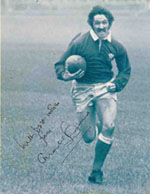 My
Rugby appreciation began then in the amateur
years and continued on during the tumultuous
dawning of the professional era to the present
day. And I had the good fortune of being
a spectator who enjoyed the thrills of the
local rugby club experience whilst also
seeing, meeting, knowing and vicariously
experiencing the highs and lows of those
at the heart of our national team. I have
been privileged enough to see the game played
the whole world over, and I have met and
conversed with some of great internationals. My
Rugby appreciation began then in the amateur
years and continued on during the tumultuous
dawning of the professional era to the present
day. And I had the good fortune of being
a spectator who enjoyed the thrills of the
local rugby club experience whilst also
seeing, meeting, knowing and vicariously
experiencing the highs and lows of those
at the heart of our national team. I have
been privileged enough to see the game played
the whole world over, and I have met and
conversed with some of great internationals.
Therefore in considering my views about
the professional era it is worth doing so
by taking the time to have a look at rugby
in a historical sense so that my opinions
and gut feelings are placed within the context
of time.
I will borrow heavily here from the text
in The Story of the Rugby World Cup, by
Nick Farr-Jones which I assisted him in
as a researcher.
Rugby is of course a game without borders,
played by people of all shapes, sizes, and
abilities and enjoyed by spectators and
followers just as diverse. From the balmy
islands in the Pacific to the chilling pitches
of northern Europe, across the expansive
landscape of southern Africa and within
the small municipality of Monte Carlo, you
will find a rugby club. There will be a
playing position and a home for the young
seven-year-old starting up in the touch
version of the game as there will be for
the seventy-year-old die-hard who still
thrills from running into sweaty bodies
even though the colour of his shorts precludes
him from being tackled.
The physical aspect of the game is often
uncompromising. It is a contact sport that
exacts its measure of punishment, but from
this there comes that sense of having done
one's bit that is known to all sports people.
Players will go hammer and tongs for eighty
minutes but once a game is over, rugby lore
deems that by-gones be by-gones as players
depart the pitch together and the usual
post-match festivities or third half, as
the French call it, commence. It is something
rugby players from the local clubhouse in
Maitland in rural Australia share with players
from other coal mining villages like Neath
in Wales. A rugby man from Waikato in New
Zealand might not speak French but given
half a chance he will have a great deal
in common with a player from Brive in France
Profond (deep France) once a rugby ball
is placed between them.
This traditional and international appeal
has allowed rugby to thrive ever since the
day the young schoolboy footballer, William
Webb Ellis, from Rugby School in England
decided, against the rules of his game,
to pick up the round ball, tuck it under
his arm and run with it. His defiant actions
became a hallmark for future combatants.
But with the tradition that quickly developed
there also came a reluctance to change.
The story of the Rugby World Cup is as much
about revolution as evolution and it tells
of those who dared to stand up to the traditionalists
and, like Webb Ellis, engender a sense of
innovation. By so doing, these visionaries
not only created one of sport's great events,
but also inadvertently gave rugby a sense
of strength and conviction that enabled
it to remain intact as the game shifted
from being a pleasure to a business, from
being an amateur pursuit to a professional
career.
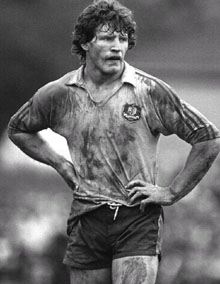 Although
rugby was included in the modern Olympic
Games on four occasions it was dropped after
1924, the American Eagles being the last
team to win Olympic gold. For decades various
players and administrators from the four
corners of the world muttered about the
need for a global event. Unfortunately none
were in ultimate positions of authority. Although
rugby was included in the modern Olympic
Games on four occasions it was dropped after
1924, the American Eagles being the last
team to win Olympic gold. For decades various
players and administrators from the four
corners of the world muttered about the
need for a global event. Unfortunately none
were in ultimate positions of authority.
The traditional custodian of the game,
the International Rugby Board (IRB) was
controlled by the Home Unions: the English,
Welsh, Irish and Scottish Rugby Unions.
They were the founding fathers of the game
and were steadfastly opposed to any talk
of a world tournament, believing such an
event would pose a direct threat to the
amateur status of the game, the tenet upon
which rugby sought to distinguish itself
from other football codes. Determined to
kill off the concept of a world tournament,
the IRB passed a ruling in 1968 disallowing
any national rugby body to host any international
competition of the world cup type.
By the 1980s other member Unions were invited
to join their esteemed British colleagues
on the holy IRB. South Africa, France, New
Zealand and Australia now had their say
on the future running of the global game.
The overbearing conservatism of the four
Home Unions did not rest easily with the
new members and a power struggle ensued.
Without a Rugby World Cup tournament there
was constant conjecture as to which team
held the mantle of the world's best in any
given generation. The Home Unions and France
played each winter in the traditional 5
Nations tournament and the mighty All Blacks
clashed regularly against the Springboks
from South Africa. This was halted in the
early eighties following the signing of
the Gleneagles Agreement banishing South
Africa from the world stage until they got
their political house in order. And the
Wallabies each year played against the All
Blacks for the Bledisloe Cup. The debate
as to who was the best would intensify on
the marvellous occasions when teams from
opposing hemispheres clashed or the legendary
British Lions toured as they did every four
years.
Despite these intense battles, or possibly
because of them, a few believers remained
steadfast in the vision they harboured to
create a proper competition to determine
the world's best, a competition that would
also showcase rugby and further establish
its international credentials. While no
one man can be given the credit for thinking
up the Rugby World Cup concept, there are
a few individuals who are central to its
story.
Such a rugby revolution required men with
strong rugby pedigrees, of significant credibility,
political nous and above all possessing
strong wills. One such man was Sir Nicholas
Shehadie from Australia. He had played 30
tests for the Wallabies in a career that
lasted from 1947 to 1958, testimony in itself
to his playing ability and tenacity. He
was a big, uncompromising man, widely regarded
as the cornerstone of the Wallaby pack having
mixed his career between the front and second
row. He was a natural leader who would have
responsibility bestowed upon him without
seeking it and would go on to captain his
country with distinction. Shehadie was widely
respected, evidenced by being given the
rare honour of playing for the British Barbarians
against his own Wallabies in 1958.
Following his distinguished rugby career,
Shehadie turned his attention to business
and also became involved in local government,
going on to serve the city of Sydney as
Lord Mayor. He would later Chair a number
of organisations including the Sydney Cricket
Ground Trust and the television broadcaster
SBS. When he assumed the presidency of the
Australian Rugby Union (ARU) in 1980, Shehadie
was determined to create a Rugby World Cup
tournament.
 The
need to bring about structural change to
the game increased in the early eighties
as rumours spread that players were being
offered vast sums of money to join a break-away
professional coup. Acting as the front man,
Australian journalist David Lord had reportedly
signed up a number of the leading players
and the urgency to protect the game increased.
Shehadie had observed the revolution in
Australia's summer sport some years earlier
when media magnate Kerry Packer had dramatically
illustrated how television and sport could
create gold when he stormed the cricket
world creating a rebel world series cricket
event. The
need to bring about structural change to
the game increased in the early eighties
as rumours spread that players were being
offered vast sums of money to join a break-away
professional coup. Acting as the front man,
Australian journalist David Lord had reportedly
signed up a number of the leading players
and the urgency to protect the game increased.
Shehadie had observed the revolution in
Australia's summer sport some years earlier
when media magnate Kerry Packer had dramatically
illustrated how television and sport could
create gold when he stormed the cricket
world creating a rebel world series cricket
event.
Shehadie flew to New Zealand to meet with
his Kiwi counterpart, Cec Blazey. There
was mutual respect and it was quickly agreed
that New Zealand administrator Dick Littlejohn
would team up with Sir Nicholas to convince
the IRB of the need for a Rugby World Cup
to maintain rugby's relevance and further
heighten its attraction to the participants
at the top level.
It was never going to be an easy task and
the two men faced significant resistance
from the member Home Unions opposed, as
always, to change. Shehadie recalls being
summonsed before the IRB in London in 1985
to defend his proposal. The Home Unions
were determined to quickly kill off any
radical change. But Shehadie and Littlejohn
would not back off and argued their case
whilst rebutting the claims that a global
event would tear at the very heart of the
game. Not that everyone in the room was
opposed to the concept, as the chairman
of the IRB that year was the affable Dr
Roger Vanderfield, a true believer in the
ideas being defended by his brave antipodean
brothers.
Finally it came to a vote. Without knowing
exactly how the numbers fell, some leaks
gave an insight into the positions adopted.
The South Africans abstained, as they no
doubt felt disinclined to commit to an event
they would not be invited to take part in.
The French, distrusting things British,
are believed to have voted for the plan.
Their administrative style can often be
compared to their playing style - daring,
exhilarating, sometimes frustrating, but
most often dramatic. For the Rugby World
Cup to get up, however, at least one of
the members from the Home Unions had to
break away. While it is unknown to this
day who that was, there is strong evidence
to suggest it was England who jumped ship
and made the vital break with the past.
The Rugby World Cup could now become a
reality and fittingly it was decided that
the inaugural event would be co-hosted by
Australia and New Zealand.
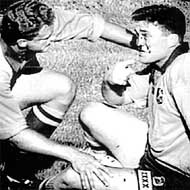 The
majestic Irish and British Lions winger
of the 1950s, Dr A J (Tony) O'Reilly said
of the Rugby World Cup that, 'For over 100
years the pleasures of rugby for players
and spectators were confined almost monastically
by region and by class, and now to echo
the words of W. B. Yeats, "All is changed,
changed utterly." The change agent has been
the Rugby World Cup and it is the nature
of this change that is so exercising and
so exciting. If the change is inclusive
and imaginative, it will improve the laws
and extend the horizons of the game. But
if it is narrow, defensive and crassly commercial
it will damage the soul of the game and
endanger the Corinthian values which have
captured the imagination of rugby people.'
There was much to look forward to. The
majestic Irish and British Lions winger
of the 1950s, Dr A J (Tony) O'Reilly said
of the Rugby World Cup that, 'For over 100
years the pleasures of rugby for players
and spectators were confined almost monastically
by region and by class, and now to echo
the words of W. B. Yeats, "All is changed,
changed utterly." The change agent has been
the Rugby World Cup and it is the nature
of this change that is so exercising and
so exciting. If the change is inclusive
and imaginative, it will improve the laws
and extend the horizons of the game. But
if it is narrow, defensive and crassly commercial
it will damage the soul of the game and
endanger the Corinthian values which have
captured the imagination of rugby people.'
There was much to look forward to.
It was perhaps ironic that within a decade
of the inaugural Rugby World Cup the code
at the top level turned professional. After
all it was the conservative British hierarchy
who had avoided the arrival of the global
event fearing it would professionalise the
code and ultimately change the fabric of
the sport.
But the pressure which drove this change
did not come from players demanding a slice
of the huge profits being generated from
the Rugby World Cup tournament, but rather
came from the fierce and acrimonious battle
between traditional rugby authorities and
the World Rugby Corporation (WRC).
The announcement of this professional revolution
was fittingly made in Paris. The southern
hemisphere nations had pushed hard for the
professional game. Their players had been
tempted by the big money being bandied about
by WRC together with Super League and they
had secured the ten-year money from News
Corporation for the Super 12 and Tri-Nations
series. As such it was not surprising that
the ARU, under former banker John O'Neill,
was well prepared for the start up of the
professional game. Recruited to head up
the ARU O'Neill brought with him the extensive
business skills required to manage the change
and ensure the books balanced after player
salaries had been paid.
But not everyone in rugby circles was happy
with the on-set of professional rugby. Little
funding seemed to end up at the traditional
grass roots. Rather the bulk of the New
Corporation funds seemed to disappear directly
into players' pockets particularly after
they threatened to sign WRC contracts. Smaller
rugby nations felt they would fall behind
without the support of their bigger brothers.
They were not a part of the lucrative Tri-Nations
or in the north Six Nations championships
and could not afford to pay their players.
Forced to remain amateur, it was inevitable
that they would lose their leading players
who would go abroad in search of the all-important
contract. In such a climate the gap between
the big and the small was bound to widen.
 The
players soon discovered that normal or day
jobs would have to be sacrificed as they
were now 100 per cent accountable to their
new employers and would be on call throughout
the day. This manifested itself in a new
mind set as players accepted whatever administrative
decisions were thrust upon them. Nick Farr-Jones
recounts the story from when he was newly
appointed the Wallaby captain Back in 1988,
when for the first time the ARU had negotiated
the logo of a Japanese communications company
to appear on the jersey. Nick and the team
had not been consulted and as players who
still pulled on the jersey for the love
and honour and not the money Nick as the
new captain, had angrily confronted the
President Joe French, insisting this could
not happen without the players' consent.
As Nick saw it he and the team were the
ones who were accountable to past Wallaby
traditions. The upshot was that the logo
disappeared. In 1997 however the ARU at
the behest of its new sponsor Reebok, paraded
a totally new jersey that was correctly
described by Peter FitzSimons as looking
like 'volcano vomit on a rag…where there
used to be a kind of holy sheen, there is
now a commercial catastrophe.' The players,
well aware of where the money was coming
from to pay their lucrative contracts, were
incapable of objecting and irrespective
of their inner thoughts went along for the
ride. The
players soon discovered that normal or day
jobs would have to be sacrificed as they
were now 100 per cent accountable to their
new employers and would be on call throughout
the day. This manifested itself in a new
mind set as players accepted whatever administrative
decisions were thrust upon them. Nick Farr-Jones
recounts the story from when he was newly
appointed the Wallaby captain Back in 1988,
when for the first time the ARU had negotiated
the logo of a Japanese communications company
to appear on the jersey. Nick and the team
had not been consulted and as players who
still pulled on the jersey for the love
and honour and not the money Nick as the
new captain, had angrily confronted the
President Joe French, insisting this could
not happen without the players' consent.
As Nick saw it he and the team were the
ones who were accountable to past Wallaby
traditions. The upshot was that the logo
disappeared. In 1997 however the ARU at
the behest of its new sponsor Reebok, paraded
a totally new jersey that was correctly
described by Peter FitzSimons as looking
like 'volcano vomit on a rag…where there
used to be a kind of holy sheen, there is
now a commercial catastrophe.' The players,
well aware of where the money was coming
from to pay their lucrative contracts, were
incapable of objecting and irrespective
of their inner thoughts went along for the
ride.
The first two years of professionalism
were turbulent. Michael Lynagh retired at
the end of the 1995 Rugby World Cup and
Phil Kearns took over the job. He then suffered
from injuries and his part in the professional
negotiations and was replaced by John Eales
as Captain. The team struggled to find the
rhythm it had enjoyed in previous years
and coach Greg Smith battled on in unenviable
circumstances during a period of time that
looked as if it was the same as before,
but which was incredibly different. None
of the familiar landmarks really existed
as they had and players, coaches, administrators
and as a consequence spectators struggled
to comprehend what was really happening.
It is within the context of these changes
that I felt a shift in my own appreciation
for the game once it became professional.
Obviously as a young man I was spoilt through
my aforementioned associations with the
game. I had come to know some of the best
players in the world and I have always believed
that it in part amateurism provided the
opportunities for that to take place. It
is no coincidence that once the professional
era began many of those whom I had known
personally to wear the green and gold had
mostly retired. One fellow who had not was
Phil Kearns, the great Wallaby hooker, and
his last years in Rugby parallel my own
relationship with the game.
During his period of injury and banishment
my allegiance to the great game had waned.
I still enjoyed watching New South Wales
play, and I went to Test matches and heartily
supported our national team but a particular
disenchantment had set in. Partly it was
due to the understanding that the sport
had become less significant in my life.
I suppose this was initially inevitable,
as the needs of creating a career and finding
an independent life meant others things
became a priority. And of course in seeing
my friends and connections retire from the
game my emotional ties were no longer as
strong.
 Professionalism
had introduced a controversy of its own
to the game, and sullied its reputation
it seemed to me. A tone of individual self
interest had crept into the vernacular where
before the team and national interest had
been the tenant upon which all others things
depended. It no longer felt like my game,
which was a churlish attitude in hindsight,
but one I felt keenly. Professionalism
had introduced a controversy of its own
to the game, and sullied its reputation
it seemed to me. A tone of individual self
interest had crept into the vernacular where
before the team and national interest had
been the tenant upon which all others things
depended. It no longer felt like my game,
which was a churlish attitude in hindsight,
but one I felt keenly.
However, this loss of interest was not
due to the fact that the Wallabies were
not necessarily performing as well as they
had in recent years. In fact I bristled
when supporters would dismissively declare
the team's efforts as hopeless whenever
they failed to win, or in fact won but not
by a margin that was expected.
Unlike a great many Johnny Come-Latelys
to the game I had followed the fortunes
of the Australian Rugby team in the early
and mid eighties and painfully witnessed
the All Blacks defeat us from any where
between one point to twenty. I never underestimated
what it took to beat any of the Home Unions
either at home or abroad. I had grown up
on a diet of Rugby folklore wonderfully
presented by the likes of Peter Fenton's
The Running Game so I knew victories were
few and far between for our small playing
nation in the past. I had stood in despair
with others to see Serge Blanco score in
the corner of Concord Oval for France to
bundle us out of the Inaugural Rugby World
Cup semi final. I had suffered the ignominy
of attending Bledisloe Cup Test matches
at the Sydney Cricket Ground, Concord Oval
and the Sydney Football Stadium as an Australian
supporter only to find that there were more
people wearing black and flying the silver
fern than our own green and gold, even when
the match was played in our country!
But it was during the season of 1998 and
1999 that I again found some of my interest
and passion of before enlivened. It was
obvious to me in particular on the evening
that I went out to watch the Wallabies play
the All Blacks at Stadium Australia in 1999
in what was their last match before heading
to Wales for the Rugby World Cup.
I was more excited about that particular
match than I had been in years. I had even
placed 20 dollars on the boys for a win
at odds of 8:1.
On paper it seemed we were doomed to lose.
Stephen Larkham and John Eales were injured
and could not play; Rod Kafer was belatedly
slotted into the pivot's role. The All Blacks
were getting stronger and stronger, they
had beaten us in the slush of New Zealand
and they were headed towards the Rugby World
Cup with the aura of favourites wrapped
tightly about them. However, I had a sixth
sense that this was actually going to be
our night and when the players arrived to
belt out the National Anthem the new stadium
shook.
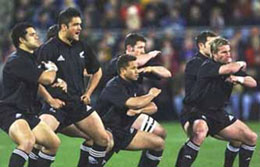 From
the moment the Wallabies assembled to face
the All Blacks and their haka I searched
for the figure of Phil Kearns, and I smiled
inwardly when I saw him. Kearns was standing,
as always, not so far away from the shouting
All Blacks, bearing a facial expression
that suggested he was bemused by the antics,
but which you knew was masking a fierce
determination to get on top of his old nemesis
yet again. He was wearing the Number 2 for
the last time on Australian soil. He had
previously announced this would be his last
year of Rugby after having played for the
last decade with a tenacity that was matched
by ability and commitment in the toughest
combatant position on a Rugby paddock. And
it was a moment of some significance even
for me. From
the moment the Wallabies assembled to face
the All Blacks and their haka I searched
for the figure of Phil Kearns, and I smiled
inwardly when I saw him. Kearns was standing,
as always, not so far away from the shouting
All Blacks, bearing a facial expression
that suggested he was bemused by the antics,
but which you knew was masking a fierce
determination to get on top of his old nemesis
yet again. He was wearing the Number 2 for
the last time on Australian soil. He had
previously announced this would be his last
year of Rugby after having played for the
last decade with a tenacity that was matched
by ability and commitment in the toughest
combatant position on a Rugby paddock. And
it was a moment of some significance even
for me.
I had met Kearns in 1989 or 1990 after
Bob Dwyer had picked him from obscurity
to tackle the Kiwis on the Wallaby tour
of New Zealand of '89. He was then and remained
a friendly fellow who never seemed to busy
to say hello and share a word or three if
we ever came across each other. In the years
between his first Test and this, his last
in Australia, Kearns had experienced the
immeasurable highs and lows of Rugby. He
had been a member of the 1991 victorious
Rugby World Cup Wallaby side and had enjoyed
victories over the South African and All
Black Rugby sides in historical encounters.
Kearns had known the best of the amateur
days and the worst of professionalism. Having
been captain of his national side at a time
when the media barons made a move on the
game professionally to own and exploit the
sport Kearns was one of those men who found
themselves placed in a position of decision
making for which they had never applied.
And then he suffered the ignominy of a crippling
injury to his Achilles' heel that all but
threatened to kill dead his Rugby career.
However, demonstrating a physical and mental
toughness he over came the worst of days
to enjoy once more the best of days. In
much the same way that Tim Horan demonstrated
an incredible single mindedness to look
beyond his awful knee injury and to return
to the world stage as the greatest player
of the 1999 Rugby World Cup so did Kearns
manage a rehabilitation that is a testimony
to any man or woman coming back from injury.
On this night that Kearns took on the Kiwis
I realised that he was the last Wallaby
of that era of Rugby I had been fortunate
enough to know intimately. He was the link
with my immediate past, when Nick, Simon
and Steve Cutler and Peter FitzSimons had
been around and so it was of a powerfully
personal moment to be there. As the All
Blacks completed their war cry and wandered
to their positions for the kick off, the
adrenalin not only poured through their
veins, but mine as well. There was an expectation
in the air that this was going to be special
and from the moment that the kick off was
taken it was a match of gladiatorial proportions.
When Australia emerged at the end of a
torrid eighty minutes emphatic victors I
was about the happiest I that have ever
been at a Rugby Test. It was the stuff of
legend and the team had proven itself in
a way that would only be surpassed by their
victories in the Rugby World Cup final,
and against the British and Irish Lions
and in the Tri Nations in the following
years. It was a victory and display that
won me over to the professional era and
I waited until the very last so that I could
watch Kearns walk around the field, holding
the Bledisloe Cup and lapping up the spectators
cheers. It was a terrific moment and although
Kearns would be cruelly robbed of the opportunity
to lift the Webb Ellis Trophy through injury
once again, his part in the transition was
completed on a positive note. And that was
enough for me to restore my faith in the
game.
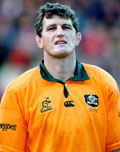 The
success of the 1999 Rugby World Cup campaign
for the Wallabies presented me with a very
real appreciation as a spectator for the
way in which professionalism could work.
Rod MacQueen had brought about a structure
to the business plan and fostered a re-identification
with the historic principles of being a
Wallaby, both on and off the paddock. Blessed
with men like Horan, Kearns, Matt Bourke,
George Gregan and Eales Rod MacQueen had
players that appreciated that there is a
need to give something to the game's name
and that the currency of choice for its
support base was not the dollar. The fact
that Bob Templeton was the Assistant Coach
was undoubtedly a contributing factor to
this shift. The
success of the 1999 Rugby World Cup campaign
for the Wallabies presented me with a very
real appreciation as a spectator for the
way in which professionalism could work.
Rod MacQueen had brought about a structure
to the business plan and fostered a re-identification
with the historic principles of being a
Wallaby, both on and off the paddock. Blessed
with men like Horan, Kearns, Matt Bourke,
George Gregan and Eales Rod MacQueen had
players that appreciated that there is a
need to give something to the game's name
and that the currency of choice for its
support base was not the dollar. The fact
that Bob Templeton was the Assistant Coach
was undoubtedly a contributing factor to
this shift.
Therefore I regard professionalism now
as something that is working well and if
managed correctly on a provincial and global
scale the game and its people will benefit
greatly from it. Of course had Rugby not
turned professional our game would have
been plundered by the league. It is a testimony
to all involved that it largely held itself
together on the international scene. What
has yet to be shown is that the powerful,
wealthy nations are in a position to look
after the minnows and whether club franchises,
as they exist in England, will become increasingly
powerful to the detriment of the international
calendar.
back
to the top of the page
back to Rugby
|